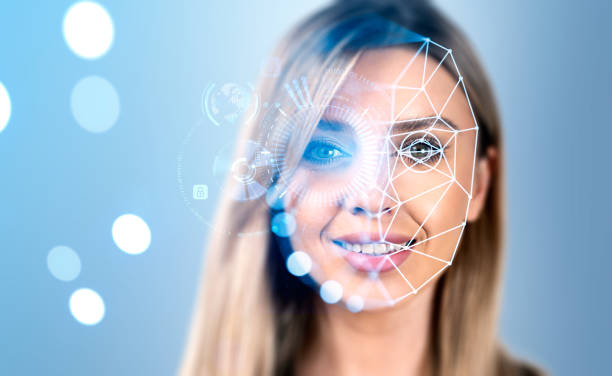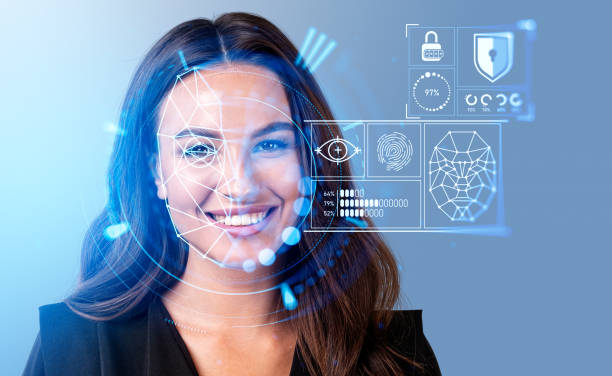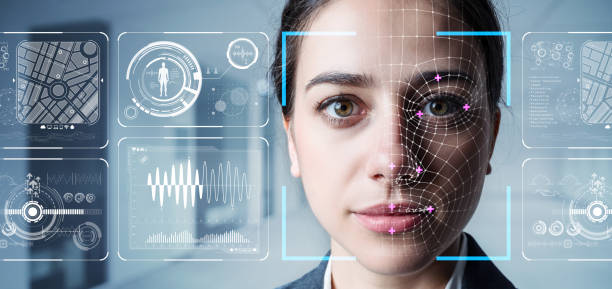Facial Recognition Modern security systems rely heavily on facial recognition technology, which has revolutionized the way we protect both private and public spaces. This cutting edge innovation, which use man-made brainpower to distinguish and confirm people in view of their facial elements, vows to improve safety efforts with unrivaled exactness and effectiveness. From opening cell phones and tying down bank exchanges to observing public regions and controlling admittance to confined zones, facial acknowledgment is becoming omnipresent in our day to day routines.There are numerous advantages to incorporating facial recognition into security procedures. Its capacity to give continuous distinguishing proof and check essentially reinforces endeavors to forestall unapproved access and recognize possible dangers. In high-security conditions like air terminals, government structures, and corporate workplaces, facial acknowledgment frameworks can rapidly and precisely match faces against watchlists, subsequently forestalling security breaks and improving the wellbeing of tenants.In any case, the arrangement of facial acknowledgment innovation likewise raises basic moral and protection concerns. The potential for abuse, observation overextend, and information breaks requires rigid guidelines and hearty shields to safeguard individual protection privileges. Adjusting the innovation’s security benefits with the requirement for protection and common freedoms is an intricate test that states, associations, and technologists must cooperatively address.As facial acknowledgment innovation keeps on developing, its job in security will probably grow, driven by headways in AI and biometric examination. It will be essential to ensure that this technology is utilized ethically and responsibly in order to maximize its potential and reduce risks. How well we manage the delicate balance between innovation and privacy in the field of facial recognition may well define the future of security.

Facial Recognition Software
Facial acknowledgment programming addresses one of the main innovative headways of the 21st hundred years, mixing the fields of man-made reasoning, PC vision, and biometrics to make frameworks equipped for recognizing and checking people in light of their facial highlights. This product works by investigating the extraordinary examples of an individual’s face, like the distance between the eyes, the state of the cheekbones, and the shape of the lips and facial structure. Using complex calculations, facial acknowledgment programming changes over these facial subtleties into a mathematical code known as a faceprint, which can then be matched against an information base of put away pictures.The utilizations of facial acknowledgment programming are tremendous and differed, spreading over across both public and confidential areas. In the domain of safety, this innovation is altering the way in which we safeguard touchy regions and guarantee public security. For instance, airports use facial recognition to speed up passenger identification, shorten wait times, and improve security screenings. Policing use it to find lawbreakers and find missing people, utilizing immense data sets to recognize people rapidly. In the corporate world, facial acknowledgment upgrades access control frameworks, guaranteeing that main approved work force can enter secure regions, subsequently forestalling unapproved access and potential security breaks.
Past security, facial acknowledgment programming is making critical advances into shopper innovation and retail. Cell phones outfitted with facial acknowledgment can be opened easily by their proprietors, offering a mix of comfort and improved security. This technology is being looked at by retailers as a way to recognize repeat customers and make offers that are based on what they like. Moreover, web-based entertainment stages use facial acknowledgment to propose photograph labels, making it simpler to arrange and share recollections.However, there has been some debate regarding the development of facial recognition software. The importance of privacy, data security, and ethical use cannot be overstated. The potential for mass reconnaissance and the unapproved assortment and abuse of biometric information present huge difficulties. Additionally, studies definitely disapprove of exactness and inclination, especially influencing minorities and other minority gatherings, prompting calls for worked on algorithmic reasonableness and straightforwardness.

As facial acknowledgment programming keeps on advancing, it is pivotal that its organization is joined by thorough moral principles and hearty administrative systems. Guaranteeing that this strong innovation is utilized dependably will be vital to opening its maximum capacity while shielding individual privileges and opportunities.
Facial Recognition Technology
Facial acknowledgment innovation remains at the cutting edge of mechanical development, blending progressed PC vision, AI, and biometric investigation to make frameworks equipped for distinguishing and checking people in light of their novel facial elements. This technology works by taking a picture of a person’s face, looking at its geometric features like how far apart the eyes are, how wide the nose is, and how the cheekbones are shaped, and then turning these measurements into a unique facial signature or template. This mark can measure up against an information base of known countenances to distinguish or confirm a singular’s personality with wonderful exactness and speed.The reception of facial acknowledgment innovation traverses various areas, fundamentally upgrading security, proficiency, and client experience. In policing, innovation is a distinct advantage, supporting the quick distinguishing proof of suspects, tackling wrongdoings all the more proficiently, and in any event, helping in finding missing people. Air terminals and line control offices utilize facial acknowledgment to smooth out traveler handling, lessening stand by times while reinforcing safety efforts against unapproved passage. In the corporate area, facial acknowledgment innovation fortifies access control frameworks, guaranteeing that main approved staff gain section to delicate regions, consequently alleviating security chances.In customer applications, facial acknowledgment is changing regular encounters. Cell phones with facial acknowledgment capacities offer clients a solid and helpful method for opening their gadgets and confirm exchanges. Facial recognition is beginning to be used by retailers to provide personalized shopping experiences and better serve repeat customers. Indeed, even online entertainment stages influence this innovation to recommend photograph labels, making it more straightforward to arrange and impart recollections to loved ones.
Notwithstanding its advantages, the multiplication of facial acknowledgment innovation raises huge moral and security concerns. The potential for reconnaissance overextend, where people can be observed without their assent, represents a danger to common freedoms. Moreover, issues connected with information security and the possible abuse of biometric information are basic difficulties that need tending to. Besides, studies have demonstrated the way that facial acknowledgment frameworks can display predispositions, especially against ethnic minorities and other minority gatherings, prompting calls for further developed exactness and decency in algorithmic plan.The application of facial recognition technology must be guided by stringent ethical standards and regulatory frameworks as it continues to advance. Offsetting development with security and reasonableness will be significant in guaranteeing that this innovation can be outfit for the long term win while protecting individual privileges and opportunities.

Facial Recognition System
A facial acknowledgment framework is a modern innovation intended to recognize or check an individual by investigating and looking at designs in light of their facial highlights. This framework incorporates a progression of intricate cycles, starting with the catch of a picture or video outline that incorporates a face. After separating the face from the background and other objects using sophisticated algorithms, distinctive facial characteristics like the distance between the eyes, nose shape, and jawline contour are extracted. These qualities are changed over into a computerized portrayal known as a faceprint, which can be matched against an information base of put away faceprints to lay out character.Facial acknowledgment frameworks are used across a wide range of utilizations, upgrading security, comfort, and personalization. In security, these frameworks assume a pivotal part in different conditions, from public lines and air terminals to get corporate offices and public spaces. They are utilized to forestall unapproved access, distinguish dubious exercises, and aid criminal examinations by recognizing suspects from reconnaissance film. Transactions at financial institutions are protected by facial recognition systems, ensuring that only authorized individuals have access to sensitive financial data.Past security, facial acknowledgment frameworks are altering shopper innovation. Cell phones and workstations with facial acknowledgment capacities permit clients to open their gadgets rapidly and safely, giving a consistent client experience. In retail, these frameworks improve client assistance by perceiving rehash clients and customizing their shopping encounters. For example, a perceived client could get custom-made proposals and offers, further developing consumer loyalty and unwaveringness. Web-based entertainment stages likewise influence facial acknowledgment to work with labeling in photographs, making it more straightforward for clients to arrange and share their recollections.
In any case, the broad reception of facial acknowledgment frameworks raises critical moral and protection issues. Personal privacy and civil liberties are at risk due to the possibility of widespread surveillance and unauthorized tracking of individuals. Also, worries about information security and the gamble of biometric information breaks feature the requirement for rigid defensive measures. Additionally, the fairness and accuracy of these systems are crucial because biases in facial recognition algorithms can result in incorrect identification, particularly among minority groups. As a result, regulatory oversight and ongoing improvements are required.

As facial acknowledgment frameworks become progressively coordinated into day to day existence, it is vital for address these difficulties proactively. Creating vigorous moral rules and administrative structures will guarantee that the advantages of this strong innovation are acknowledged while safeguarding individual privileges and keeping up with public trust.
How Does Facial Recognition Work
Facial acknowledgment innovation manages a modern interaction that includes a few key stages, each utilizing progressed man-made brainpower and PC vision procedures. At first, the framework catches a picture or video outline containing a face utilizing a camera. In order to standardize the input for subsequent analysis, the system performs preprocessing on this image, in which it adjusts for orientation, scale, and lighting conditions. The following stage includes face identification, where the product recognizes and disengages the face from the foundation and some other articles in the picture. This is normally accomplished through calculations like Haar fountains or more present day profound learning strategies, for example, convolutional brain organizations (CNNs).When the face is distinguished, the framework continues to remove special facial elements. This interaction, known as component extraction, centers around unambiguous milestones on the face, like the eyes, nose, mouth, and the general state of the face. These milestones are utilized to make an exceptional numerical portrayal or a faceprint, which encodes the unmistakable qualities of a singular’s face into a vector of numbers. High level calculations examine these elements and make an interpretation of them into an organized organization that the framework can use for correlation.
The faceprint is then looked at against a data set of known faceprints. This examination cycle, frequently alluded to as coordinating, includes estimating the closeness between the caught faceprint and those put away in the data set. The closest match is chosen by the system using a variety of matching algorithms like cosine similarity or Euclidean distance. In the event that a match is found inside a predefined edge, the framework effectively distinguishes or confirms the person.Facial acknowledgment frameworks are ceaselessly refined to further develop precision and dependability. The system is able to learn from new data and adapt to variations in facial appearances due to aging, makeup, facial hair, or accessories like glasses and hats thanks to machine learning, which plays a crucial role in this refinement. Also, a frameworks consolidate liveness recognition to recognize genuine faces and photos or veils, improving protection from satirizing endeavors.Notwithstanding its innovative refinement, facial acknowledgment faces difficulties connected with precision and moral worries. Issues like shifting lighting conditions, looks, and segment inclinations can influence execution. Tending to these difficulties requires continuous headways in algorithmic plan and the execution of powerful moral rules to guarantee the innovation is utilized dependably and impartially.

Facial Recognition Examples
Facial acknowledgment innovation has tracked down a wide cluster of uses across various areas, exhibiting its flexibility and effect. Its application in security and law enforcement is one notable example. Air terminals all over the planet, for example, those in Dubai and Singapore, utilize facial acknowledgment frameworks to smooth out traveler ID and improve safety efforts. These frameworks can rapidly coordinate voyagers’ appearances with their identification photographs, decreasing stand by times and working on the proficiency of movement checks. Policing use facial acknowledgment to recognize thinks and address wrongdoings all the more effectively. For example, the Metropolitan Police in London have effectively utilized this innovation to recognize and secure suspects from observation film.Facial recognition is changing access control systems in the business sector. Organizations like Macintosh and Google have incorporated facial acknowledgment into their items, for example, cell phones and workstations, permitting clients to open gadgets and verify exchanges safely and advantageously. This biometric security include has turned into a norm for safeguarding delicate data and guaranteeing that main approved people can get to specific regions or information.Retailers are likewise investigating facial acknowledgment to upgrade client encounters. For instance, a stores in China utilize facial acknowledgment to recognize steadfast clients and deal customized shopping encounters. Customers can be identified by this technology upon entering a store, their preferences can be tracked, and products that are tailored to their preferences can be suggested, thereby increasing sales and customer satisfaction. Along these lines, installment frameworks like Alipay have consolidated facial acknowledgment for secure and consistent exchanges, permitting clients to pay with a straightforward look at a camera.
Social media is also seeing progress with facial recognition. Stages like Facebook utilize this innovation to recommend labels in photographs, making it simpler for clients to arrange and share their recollections. This element upgrades client experience as well as assists in reconnecting with loved ones by recognizing people in old photos.Be that as it may, the developing utilization of facial acknowledgment models is joined by critical worries with respect to protection and moral ramifications. The potential for abuse, for example, unapproved reconnaissance and information breaks, highlights the requirement for severe guidelines and moral rules. Guaranteeing the innovation is utilized dependably, with deference for individual protection and information security, is essential as its applications keep on growing.The fluctuated instances of facial acknowledgment applications feature its capability to change different parts of day to day existence, from upgrading security and comfort to customizing shopper encounters. As the innovation advances, addressing moral and security concerns will be vital to understanding its full advantages.

Airlock Technology in NASA’s Voyager Program